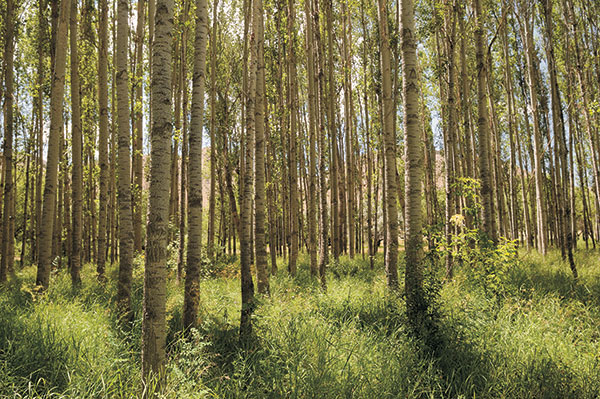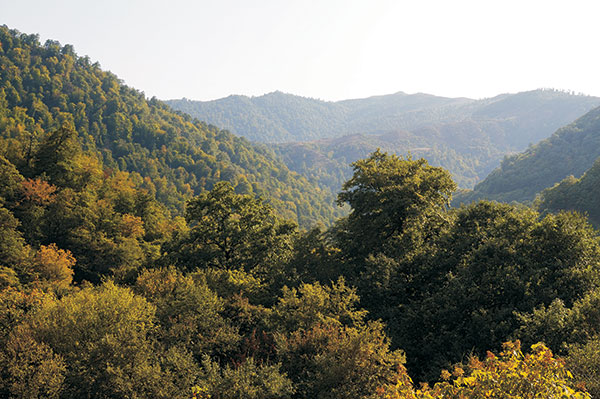 Azerbaijan covers an area of 86.6 million hectares, of which 1213.7 thousand hectares are forests. Forestlands of 989.5 thousand hectares form 1.4% of the total land area of Azerbaijan. There are approximately 0.12 hectares of forestland per capital, which is four times (0.48 hectares) lower than the average figures worldwide.
Azerbaijan covers an area of 86.6 million hectares, of which 1213.7 thousand hectares are forests. Forestlands of 989.5 thousand hectares form 1.4% of the total land area of Azerbaijan. There are approximately 0.12 hectares of forestland per capital, which is four times (0.48 hectares) lower than the average figures worldwide.
Forests in Azerbaijan belong to group I for their important degree and are spread differently throughout the regions of the country. One of the specific features of these regions is the availability of various natural resources, such as mineral water, energy, and fertile soil. The forests serve a function that no other natural components can. Forests are the natural matters that promote the stabilization of such important biosphere components as water, air, and soil.
The forests of Azerbaijan (85%) mainly cover the slopes of the Major Caucasus, Minor Caucasus, and Talysh Mountains.
Most of the forests have rather valuable tree types (iron tree, beech tree, hornbeam, lime, maple, etc). The characteristic trees of the forests and their diversity are determined by the climate, soil, and topography of the region.
The forest policy of the country is managed by the Department for Forests Development under the Ministry of Ecology and Natural Resources.
The department takes care of the protection and preservation of forests, restoration and planting of forests, preparation of planting stocks, storage of forest trees and bushes, preservation of forests, and other forestry actions, which includes the efficient and purposeful utilization of forest reserves and related spheres of agriculture. It also works on the improvement of the protection of forest soil, water preservation, a clean environment, sanitarian and hygienic actions, preservation of species of animals in the forests, ensuring biodiversity, the establishment of cultural, scientific, and recreational complexes throughout nature, as well as the protection and expansion of the gene pool in the growth of forest seed.
The Department for the development of forestry controls 34 establishments for regional forest protection and restoration, 3 institutions of forestation, and 3 establishments for forest seeding (The scientific research of forestry institute and the center of the struggle against pests and diseases.).
Since the establishment of the Ministry in March 2001, the number of measures conducted for restoration of forests, forestation, cultivation of planting stock, seed storage, and others has increased.
By decree of the National leader of the Azerbaijan Republic of December 26, 2001, The Ministry of Ecology and Natural Reserves was instructed to develop and submit for consideration of the Cabinet of Ministers of Azerbaijan, the National program for the restoration of fields and expansion of their area through attracting state and regional administrative bodies and scientific societies.
The decree also stipulates for the Ministry to develop a National program for rational use of all the year-round pasture and hayfields, prevention of soil erosion on mountain hills, valleys, and ravines and the salinization of lands in foothill and plain regions for the stable ecological, socio-economic development and the development of cattle-breeding and farming and to introduce is to the authorized body.
The draft program "On forest restoration and expansion", developed by the Ministry of Ecology and Natural Resources for the implementation of the Presidential Decree with certain alterations and additions was approved by Presidential Decree No 1152 of February 18, 2003.
The program stipulated for the restoration of forests and forestation in all regions on the area of 69700 hectares in 2003-2008.

Since the establishment, the Ministry of Ecology and Natural Reserves has initiated large scale projects in the formation of forest preserves in arid areas, tree planting in the outskirts of cities, by the sides of roads and highways, the establishment of new tracks of forests, and restoration of forests by conducting consequent and proper ecological policy beginning from May 2001.
Newly established enterprises for forestation and Enterprises for Forest Protection and Restoration, operating in various regions of the country, conducted activity on forest restoration and planted new forests on the area of 7753 hectares in 2002 and the territory of 8721 hectares in 2003 in frames of the National Program. These indicators are by 1.6-1.9 higher than the volume of work, carried out in 2000-2001 accordingly.
The purposeful actions in the sphere of planting materials creation have been undertaken as well.
Thus, 12 million planting materials and 32 million planting materials were grown in 2002 and 2003 accordingly. The indicator is by 2-5 higher from that of 2000-2001 accordingly.
The forest restoration and forestation area were forecasted to reach 9000 hectares while the amount of planting materials-35 million in 2004. As a result of organizing measures, 40 million planting materials have been created, new forests been planted on the area of 3700 hectares while measures, aiming to assist in the restoration of natural resources have been conducted on the area of 5403.
Forest restoration actions in 10131 ha, forest sowing works in 2746 ha were implemented in 2013. Measures to help the natural restoration of forests were accomplished in 7385 ha.
According to the final reports of 2005, in the last reporting year, reforestation measures were carried out on 9737 hectares against 9500 hectares of reforestation measures. Of this, 3,860 hectares is afforestation. The remaining 5,877 hectares are natural recovery assistance measures. 35 mln. 38 million against the number. pieces of planting material were grown. These figures are 2-2.5 times higher than in 2000-2001 for reforestation measures, and 6-10 times higher for the cultivation of planting material.
In accordance with the requirements of the "National Program on Reforestation and Enlargement", in 2006 the plans and forecasts of reforestation measures were increased to 10,000 hectares. Currently, work is underway in this direction.
In 2013, reforestation measures were carried out on 10,131 hectares, including afforestation and sowing on 2,746 hectares. Measures to support the natural restoration of forests were carried out on 7,385 hectares.



